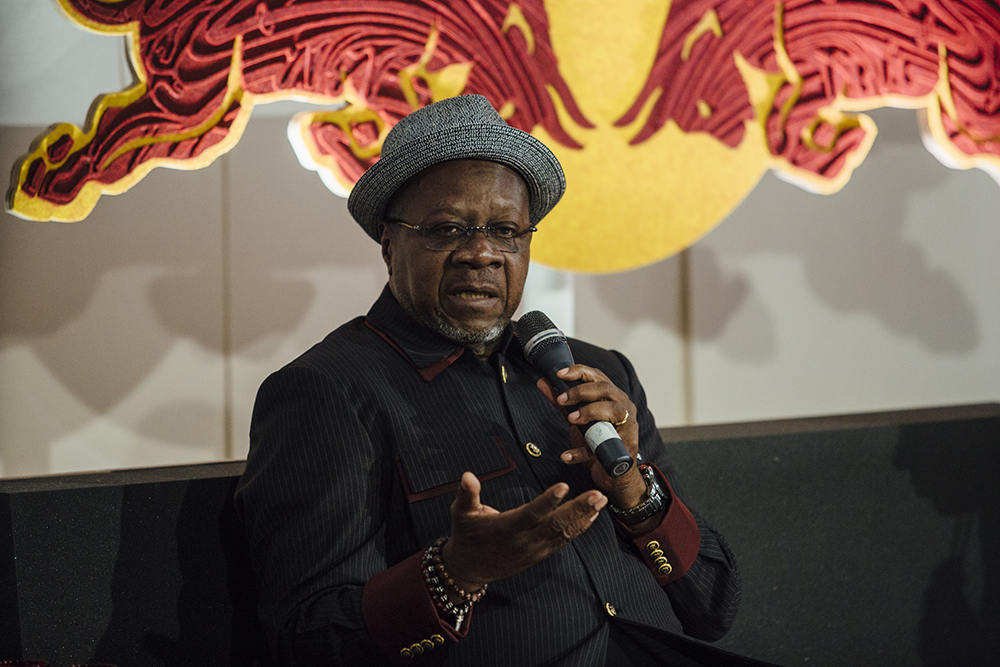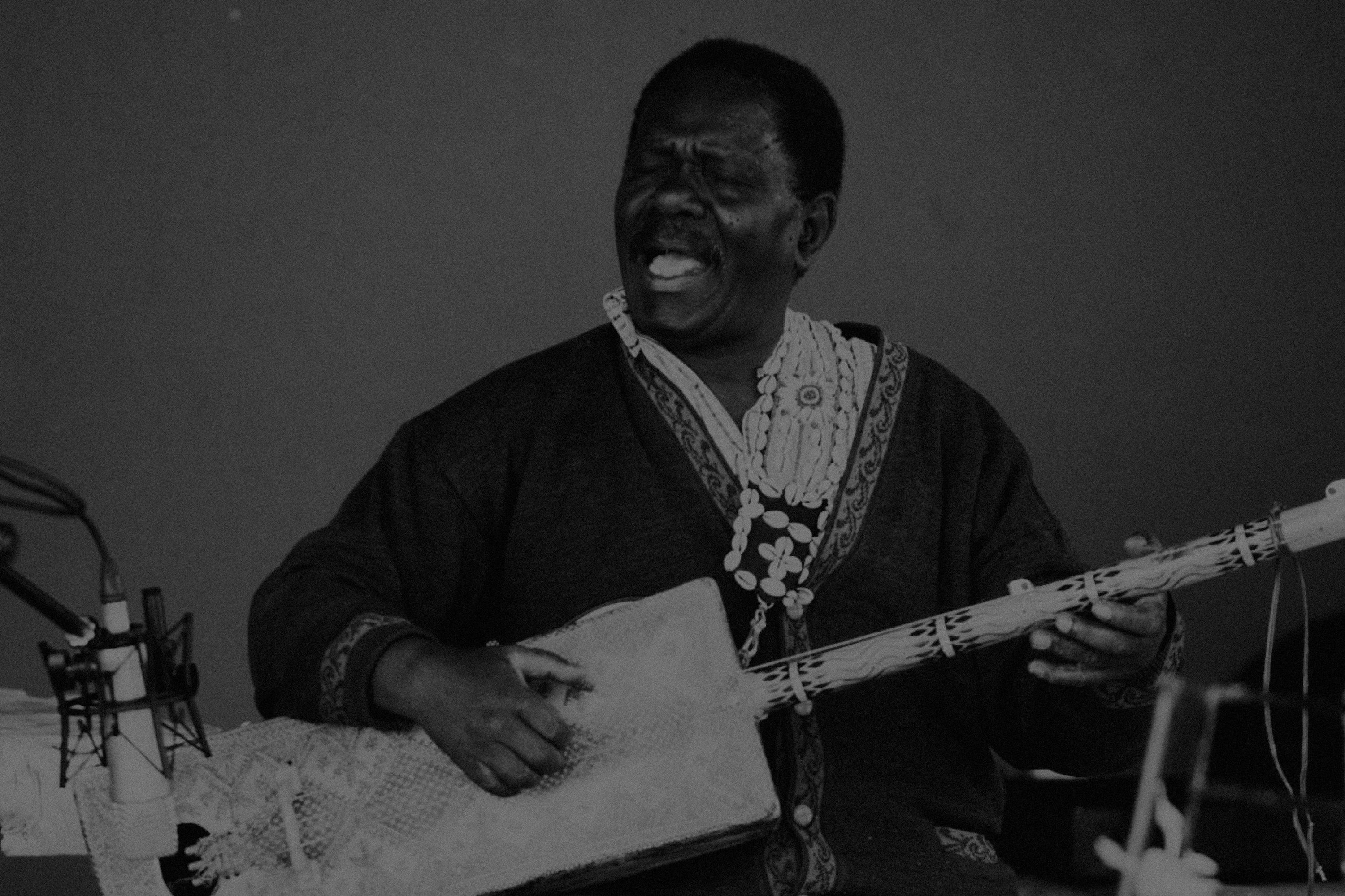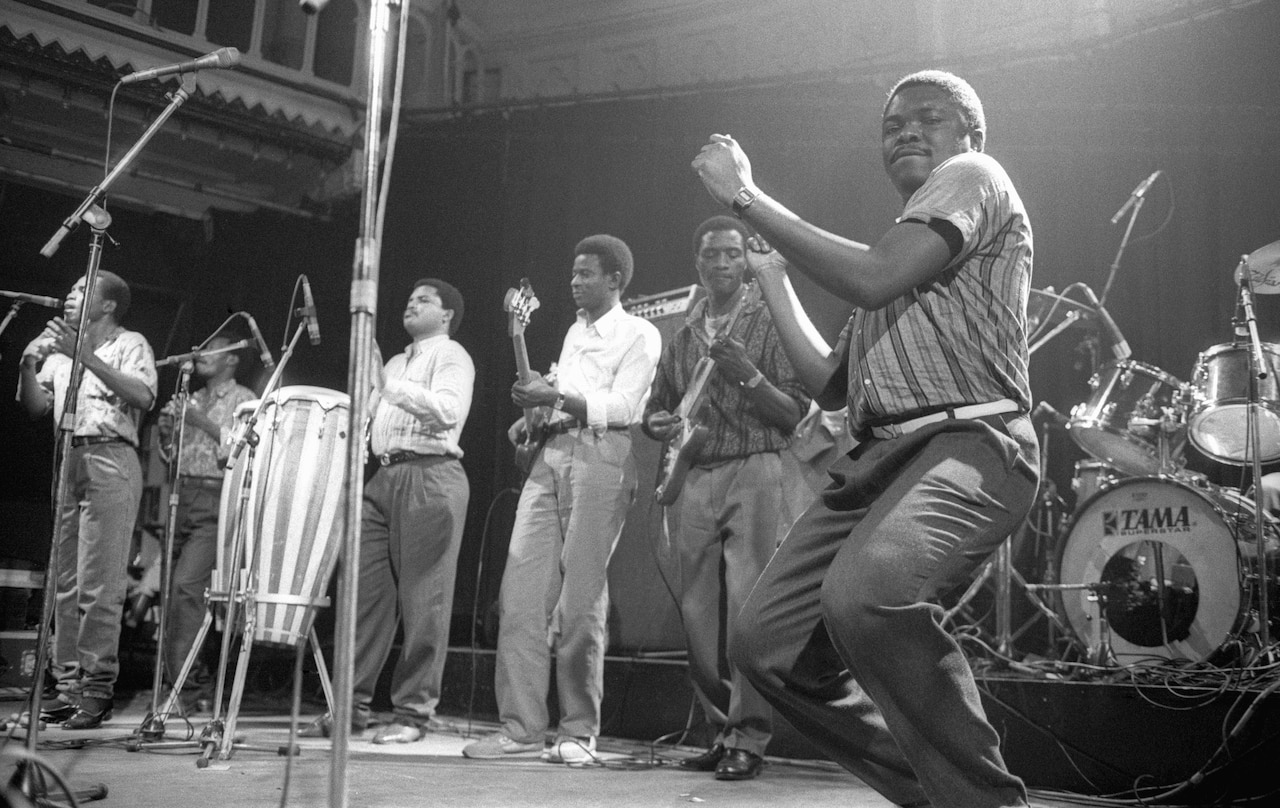
Seben Heaven: The Roots of Soukous
Mapping the evolution of a defining Congolese sound, from Cuban origins through to its accelerated final form
Kanda Bongo Man’s 1987 hit “Sai” is an assault of joyful energy from the opening note through to the last: Diblo Dibala’s lead guitar rings clearly above Guadeloupean drummer Ti Jean’s pounding kit, while Pablo Lubadika Porthos’ slick bass lines and Lokassa Ya Mbongo’s expert rhythmic twang provide a solid springboard. As the music takes off, Kanda shouts “kwassa kwassa” and the band shifts into high gear. This powerful studio production is archetypical Parisian soukous, recorded with a studio ensemble of household names – all stars in their own right – and aimed directly at the clubs. But what is this rapid-fire, guitar-driven music that swept Europe in the ’80s? Where did it come from, and where did it go?
Known in Europe as soukous, across Eastern and Southern Africa it was more often called kwassa kwassa, from the French expression, “c’est qoui ça?” (literally, “What is that?”) However, in Zaire, at the time under the rule of the paternalistic dictator Mobutu Sese Seko, it was mostly rejected by fans as a poor bastardization of their rich musical tradition, the Congolese rumba. To understand why, we have to go back to the very beginning.
.17bb7ad7.png?auto=format&w=700)
Congolese music had been popular across the African continent for over three decades before it made much of an impact in Europe. Early examples are often slow in tempo, featuring close harmony singing, bouncy light percussion and, perhaps most importantly, virtuosic guitar playing. This unique style of local popular music was simultaneously developed in Leopoldville (now Kinshasa) and Brazzaville, the capital cities of the Belgian and French colonies on either side of the Malembo pool of the Congo river.
In the ’30s, local amateurs began taking inspiration from traditional music, French popular music and American jazz. Son cubano records heard floating through Radio Congo Belge, and imported physically on the G.V. series, played an especially key role. By the late ’40s local labels including Ngoma, Longingisa and Opika – all run by Greek immigrant entrepreneurs – began recording Congolese musicians and exporting their records internationally. The musicians often sang in phonetic Spanish or French, the language of the oppressor, but increasingly preferred Lingala, a trade language that crossed ethnic and regional barriers. Lingala has a sweetness and flexibility that lends itself to poetry which helped push the music far beyond the twin cities on river.
This music became known as rumba Congolaise because the imported records of Sexteto Habanero and Trio Matamoros were mislabeled rumba, an entirely different Afro-Cuban folkloric music. The influence of Cuban Son is clear on the massive hit “Marie Louise,” recorded in 1948 by Wendo Kolosoy and Henri Bowane. Bowane’s brief but energetic guitar solos hint at developments to come, invoking the sound of traditional likembe thumb pianos – best known worldwide as a mbira – and stringed instruments played across the region. In the bars of Kinshasa, Bowane reportedly stretched these solos into an extended dancing section, which became known locally as seben(e).
Once the seben arrived, there was no going back to the verse, similar to how the montuno functions in salsa music.
The prevailing theory is that the word seben entered Lingala at the same time as the acoustic guitar, introduced to the region by a community of sailors and dockworkers from Sierra Leone, Dahomey (now Benin) and Ghana, who came to the Congo basin in the ’20s and ’30s. Seventh chords were commonplace in their proto-Highlife, even barking out ”seven” to signal the musical changes in the solo section. The seben became more central to Congolese music as early pioneers reconfigured and revolutionized their relationship with the instruments in their hands.
Perhaps the most groundbreaking guitarist in Congolese music history is Nico Kasanda, known as Docteur Nico. His smooth style influenced generations of Congolese guitarists to come; simply, there would be no soukous without Nico. At 14 years old, he joined the singer Joseph Kabasele, known as Le Grand Kallé, with the group l’Africa Jazz; together they scored important hits, including “Table Ronde,” a celebration of the successful independence movements sweeping the continent. Nico’s free-flowing and lyrical guitar solos shine on two decades of hits first alongside Grand Kallé, then in the group African Fiesta, with Tabu Ley Rochereau, and later in his own group, Fiesta Sukisa. His fiesta style – which flashes across “Mbombo Ya Tshimbalanga” with Grand Kallé, “Biantondi Kasanda” with African Fiesta, and “Bougie Ya Motema” (with that staccato seben recurrent again) – drew on traditional Baluba melodies and rhythms lifted from his home village Mikalayi, in Congo’s south-central Kasai region.
However, it is guitarist, singer and bandleader ‘Franco’ Luambo Makiadi who is often credited with transforming the seben into the main focal point of Congolese music, rather than a departure between choruses. While Docteur Nico played smooth, flowing improvisations that rarely were heard twice, Franco’s style – known as odemba – was rougher, more repetitive and rooted in rhythms that moved the hips of dancers at Kinshasa’s hottest clubs, like the Vis-à-Vis. Meanwhile, new 45rpm pressing technology gave musicians the freedom to stretch the recordings out accordingly. Yet rumba of the ’60s was still a slow glide comparative to the great leap forward that was to come.
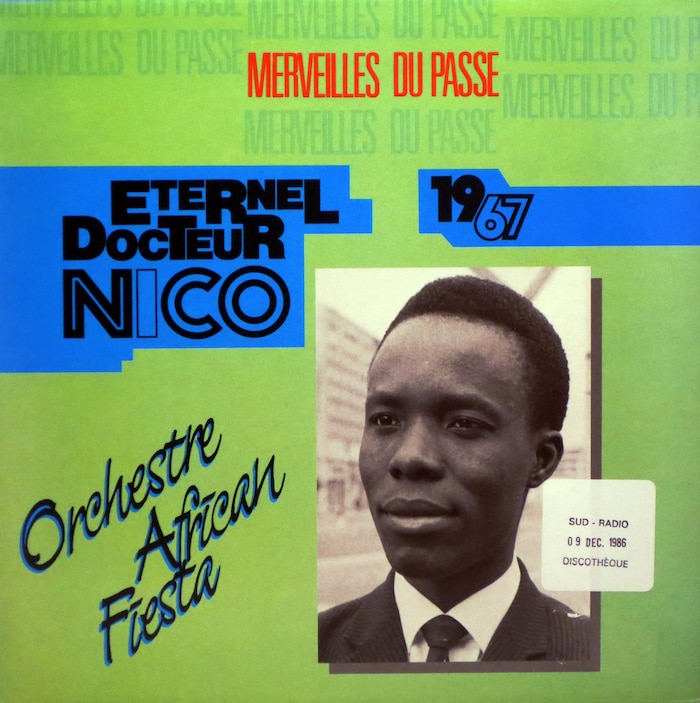
Just as ‘Afrobeats’ today is used as an umbrella marketing term to promote different styles of popular African music to Western audiences, ‘soukous’ was chosen by Island Records producer Ben Mandelson and Togolese entrepreneur Richard Dick as the title of a 1982 compilation, Sound D'Afrique II: Soukous. The compilation included music from Mali and Cameroon alongside “Madeleina,” a tune off Pablo ‘Porthos’ Lubadika’s 1981 album Ma Coco, which had been a head-turner in Europe. The tempo is hot from beginning to end, with a steady kick underpinning sizzling hi-hats, and guitars that are bright as the midday sun. Earlier the same year, Pablo played on Pamelo Mounk’a’s l’Argent Apelle l’Argent, another hit release in the same ballpark.
Though Pablo didn’t create this style, his influences are easy to trace: He arrived in Paris in 1979 alongside singer Sam Mangwana, via Lomé, Togo. There, they had just recorded under the name The African All Stars. Mangwana, who had already recorded with near everybody in Congo, moved to Abidjan in 1978 seeking out brighter pastures. He forged a new band of Congolese economic exiles, all of whom were to become regulars in Parisian session bands – including the guitarists Dizzy Mandjeku and Lokassa Ya Mbongo, plus drummer Ringo Moya. The All Stars’ big hit, “Suzana Coulibaly,” is built on simple, repeating rhythms at a faster tempo than the usual rumba, highlighting Lokassa’s guitar eruptions. Mangwana shouts out “soukous sophistiqué” as Lokassa and Ringo construct a rock-solid seben. This record established the direction that Pablo, Pamelo, Kanda Bongo Man and others ran with in Paris, starting an independent musical movement focused on winning an international market.
In cavacha, the snare pounds a clear patter that cuts through the wall of shifting guitars, as singers cry small shouts of joy, call out dance steps, or sing three-part harmonies.
As their clout increased, so too their speed. The African All Stars adopted and adapted the fast ’n rough stylings heard among youth bands in Brazzaville and Kinshasa, and introduced the new tempo internationally. It was a key concession to an emerging musical movement. That pace was shunned at the time by established musicians – which is why Mangwana was at pains to affirm their style was indeed “sophisticated soukous.”
In the late ’60s and early ’70s, many so-called yéyé youth bands started stealing the spotlight from more established stars like Franco and Tabu Ley with their exciting new rhythms and dances. They pushed the tempo of the rumba, stretched out the seben and slapped a new name on it: secouss, from the French secouer, “to shake.” More established artists including Les Bantous De La Capitale and Tabu Ley Rochereau quickly picked up on the dance, spreading it across the continent.
Kinshasa-based youth groups like Zaïko Langa Langa and Orchestre Kiam did away with the horn sections favored by the bigger bands, focusing on a rhythm section of two or three guitars, bass, drums, percussion and three singers. They also introduced a two-part song structure that highlighted the seben – once the seben arrived, there was no going back to the verse, similar to how the montuno functions in salsa music. These youth groups also added synchronized dancing on stage, taking inspiration from funk and soul but also traditional dances for their steps.
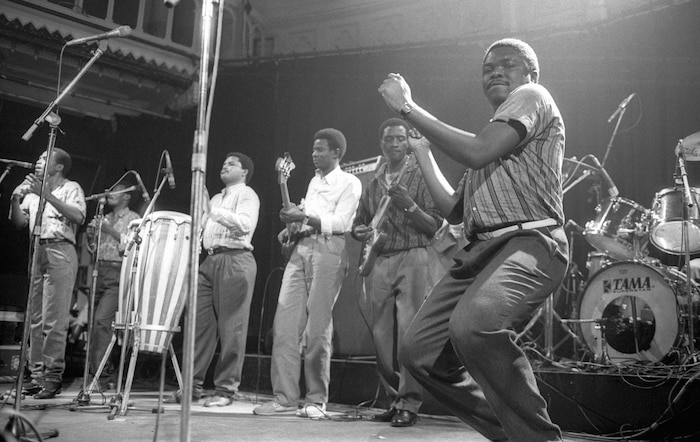
When Zaïko Langa Langa brought a new rhythm and dance called cavacha, it swept the entire scene from the bottom up. Cavacha is truly the musical root of soukous. The story goes that the band asked their drummer, Meridjo, to imitate the sound of a train on the tracks on his snare. However, Meridjo himself has disputed this; the rhythm was in fact adapted from a pattern he heard a traditional drummer playing one night in a Kinshasa bar. This snare rhythm is as central to Congolese music as it is to Cuban music, where it known as la clave (the key). Zaïko gave an old rhythm a new name, cavacha, though they also called it “Machine ya Kauka”: The train of Kauka, a neighborhood in Kinshasa. The snare pounds a clear patter that cuts through the wall of shifting, hypnotic guitars as the singers cry small shouts of joy, call out dance steps, or sing three-part harmonies.
Popular numbers poured out of Zaïko, including “Mbeya Mbeya” and “Muvaro,” which showcases the high-energy dance zekete zekete and a new complimentary factor. Zaïko introduced the role of a dedicated hypeman – known as atalaku or animateur – into the corps of singers, starting a trend that informed Parisian soukous of the ’80s and continues in the big bands today.
The third generation of Congolese music grew like a tree from the fertile root of Zaïko, as many of the founding members split off to form their own groups, which in turn split into more groups: Isife Lokole, Grand Zaïko Wa Wa, Langa Langa Stars, Clan Langa Langa, Choc Stars and Anti-Choc amongst them. Of all the branches, Papa Wemba and Viva La Musica made the longest-lasting impact, partly because Wemba managed to keep one foot in Paris and one in Kinshasa – and, coyly, a different version of his band based in each city. His ’80s hits like “Analengo” incorporated stylistic elements of the Paris sound without shortchanging his Congolese fans on the lyrical content.
Meanwhile, the scene in Paris moved to its own, faster beat, with fewer fixed groups and more rotatable studio ensembles cranking out hits as fast as the start-up labels like Eddy’son, Bade Music Stars and Afro-Rythmes could get them out. As more and more Congolese musicians arrived in Paris fleeing the increasingly damaging economic collapse of Mobutu’s Zaïre, they joined musicians and producers from across Central Africa and the Antilles to create the best-known hit parade of ’80s soukous.
In the studios of Paris, the seben guitars blended with the tight drum machines and synths of zouk and funky disco makossa on hundreds of records. The multi-talented Rigo Star played guitar and produced hits for everyone from Kanda Bongo Man, Mbilia Bel, Abeti Masikini and a young Koffi Olomide, who would go on to further stardom in the 1990s. Diblo Dibala and Aurlus Mabele swept the clubs with Africa Moussou, creating a hyperactive style of super-speed soukous, dubbed TGV soukous by fans – for France’s zippy trains.
Back home, this rapid churn felt formulaic and market-driven, and failed to connect. Congolese music fans tend to value the poetic lyrics and harmonious singing even more than energetic dance music; the seben is important, but not at the expense of songwriting. In Paris, the rhythm was king. Musicians shortened and tightened the form of the songs, doing away with anything more than the suggestion of a verse before jumping into a fast-paced seben for the majority of the piece. Thus, a schism that was to ultimately crimp the creativity of soukous as the ’80s became ’90s. Today’s stars, like Fally Ipupa and Ferré Gola, have found a welcome middle ground, including at least one or two dance tunes per album, but focusing primarily on the slower-paced rumbas that hark back to the sound’s origins. But whatever school of soukous you subscribe to, one thing can be agreed upon by both sides: There is simply no denying the fire of Diblo Dibala’s guitar.
Header image © Frans Schellekens
